Berlin Day 6
We started our day by making a stop at a large array of "stolperstein," which are brass plaques commemorating Jewish people who were persecuted under the Nazis. These ones were placed outside of the federal office where these people worked. These stones had been affected by time and weather, so using some basic restoration products, we cleaned each of the stones to bring them back to the original brass they once were. During this process, we read the people's names aloud, along with the years of birth and other information on the stones, including when they were forced to retire, fled the country, stripped of their German citizenship, and/or arrested. As we cleaned the stones, several people stopped to comment on or ask about what we were doing, giving us an opportunity to explain to others the importance of commemorating those who were victimized by the Nazis.
...
Stolpersteine as encountered in-situ before restoration
Stolpersteine post-restoration effort
...
We then walked back to the Memorial to the Murdered Jews of Europe and re-walked the path, noticing how the change in weather and lack of shadows from the blocks due to overcast sky made a difference in the way we experienced the walk compared to yesterday.
Across the street, we looked at the Memorial to Homosexuals Persecuted Under Nazism from afar since it was fenced off for the Euro Cup. We noted the similarity in style and stature between the two memorials.

Onwards, we passed fragments of the Berlin Wall at Potsdamer Platz which has become heavily commercialized and corporatized in the 21st century after being a barren space for decades prior. These Wall pieces had the accumulation of the public affixed to them, rendering the walls amorphous and lumpen adding chewed wads of gum, piece by piece.
We paused to reflect on this very different approach to the Wall then what we had come across prior and pondered whether this was a sign of disrespect, a representation of the many, and/both a confrontation of what was previously not permitted. Rather than iconically chipping away at the sections of Wall here, these were built upon.
Along the way to our next stop, Checkpoint Charlie, we passed by pieces of the Berlin Wall and the Topography of Terror.
Arriving at Checkpoint Charlie, we discussed the importance of the site; Checkpoint Charlie served as a significant crossing point at the Berlin Wall during the Cold War. Jackson read about the often neglected photography installation by Frank Thiel drawing from his portraiture index, cataloging headshots of soldiers tasked with guarding the Wall in the four respective zones during the Cold War era urban divide. The photographic installation of a double-sided box on top of a tall pole has a Russian soldier looking East and an American soldier looking West. The piece melds into the reclaimed site in an optic yet under-acknowledged way as a memorial in its own right... the place is reclaimed, yet as what? –From border crossing standoff to tourist trap photo-op.
After the Checkpoint, we walked to the subway and headed to the Turkish street market on Maybachufer in the inter-neighborhood of Kreuzkölln, in Berlin's "Little Istanbul" district, which installs itself along an offshoot of the Spree River every Tuesday and Friday.
We walked along the entire street of stands, offering food, clothing, jewelry, and other goods. Some of us grabbed Turkish food, others had African cuisine, and some had Tibetan, which we found to be a great way to immerse in the melting pot of cultures that Berlin has proven to be. After eating, some of us ventured to the other stands in the market and bought some jewelry. Some of us enjoyed a cool sweet treat called chimney rolls, or Kürtőskalács, originally from Transylvania and since widely popular all over Hungary and Romania.
Once wandering the market stalls came to an end, the majority of us went and sat by the railing that overlooked the riverbank. Sitting there, after wandering through the market, we could hear the sounds of the bustling people and the stand workers hawking their goods to customers, and reflected on how we received a great sense of the diverse German culture because of the various people and languages we listened to.
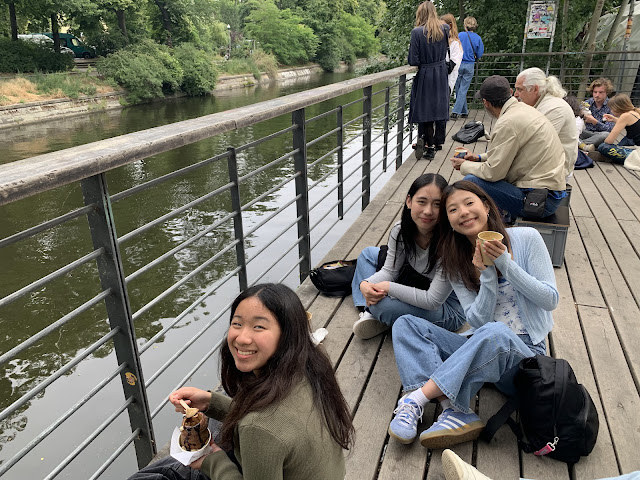

Soon it started to rain and we all shuffled onto a sidewalk to sit under an awning and gain shelter from the passing water from above. We had some interesting conversations, and when the rain let up, we headed to our next stop.
After a couple of public transit junctions and some walking, we arrived at the Stasi Museum, where we learned about the infamous secret police of East Germany at their previous headquarters.
Most of us learned, and a few of us relearned, about the variety of ways that the Stasi monitored and controlled the people of East Germany, creating paranoia among the people. We saw pictures of some informants' faces, more formally known as the Unofficial Employees of the Stasi, and saw the variety of recording devices and equipment that the Stasi implemented into everyday objects; one example was a recording device hidden within a car that used infrared light and laser sensors to record people at night. Another example was a camera hidden in a watering can.

We also went upstairs to the former offices of the Stasi higher ups, which have been preserved in their originality. One office belonged to Erich Mielke, the head of the Stasi. We also saw some other remnants of the headquarters, like the Paternoster elevator, an elevator without a door that requires someone to hop in while it continues to move. We ended the tour of the museum with talking about the cultural schisms that remain between East and West Germany due to the wall and how the Stasi played a roll in enlarging that divide between the German people.
A question one of us posed to the tour guide about the Stasi Archives, located in another building in the huge complex, revealed an incredible fact. Upon the fall of the Wall, the Stasi set about shredding thousands upon thousands of documents keeping meticulous tabs on all walks of life in East German society. Despite being shredded, these scraps were recovered and are slowly being puzzled back together, a page at a time. Our tour guide shared that it is estimated to take another 263 years of constant labor to reassemble everything the Archives possesses!
We then took the Ringbahn public transit line to a statue of former Soviet leader Ernst Thälmann, a familiar monument that we had previously posed in front of the model of on our field excursion to the Wende Museum in Culver City this past spring.
We used this Soviet square to split into our four study groups -- Commemoration of the Urban Fabric, Structures of Ruin and Reclaim, Object-Symbols of Division/Unification, and The Newcomer & the Exile -- to annotate on our respective city maps the sites and places we had encountered thus far in our urban lab. The base of this monument also served as a stage to reclaim joy.
We then headed to dinner at an Indian restaurant which included the fried steam-pocket pillow bread called Bhatura, which is found in every Indian restaurant in the Berlin. Many people were out celebrating the start of the Euro Cup, and the restaurant, like many others, was projecting the first game on their front patio. This afforded us a wonderful interior dining room all to ourselves without reservation!
After dinner, we rode our first strassenbahn (street car) to the Empty Library Memorial at Bebelplatz on Unter den Linden, which consists of an inaccessible, underground room of empty book shelves located directly across from the Humboldt University.
Upon arriving, due to the sun setting, we could see into the brightly-lit underground library through a square meter glass window installed on the ground to allow views down into this hollow structure just below our feet.
The Empty Library serves as a memorial to the burning of some 20,000 books at the hands of the Nazis in 1933 in this same city square. We passed around and read aloud from the Twelve Theses, written by the German Student Union under National Socialism, a document which is cited as the kindling for the eventual book burning event.
We discussed how the loss of the books represents the loss of knowledge and culture. Ms. Fleming shared that this symbolic library memorial was designed to be underground to prevent neo-Nazis from returning to the site and defacing the memorial. Flooded in white light, the empty shelves reflect what used to be present in the square but is now gone.
Although the day ended solemnly with the library memorial, we ended up learning a lot of interesting history about Berlin while simultaneously immersing ourselves in the culture. We can't wait to see what the rest of the trip will bring us.
-Elissa '26, Esmé '26, and Danica '27





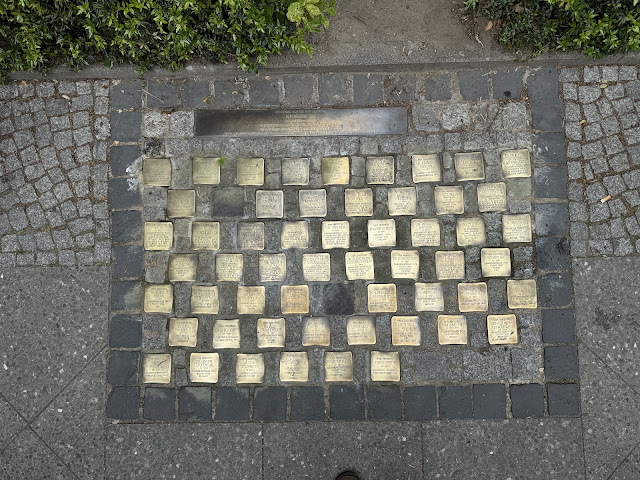












































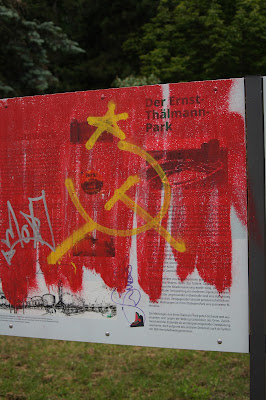






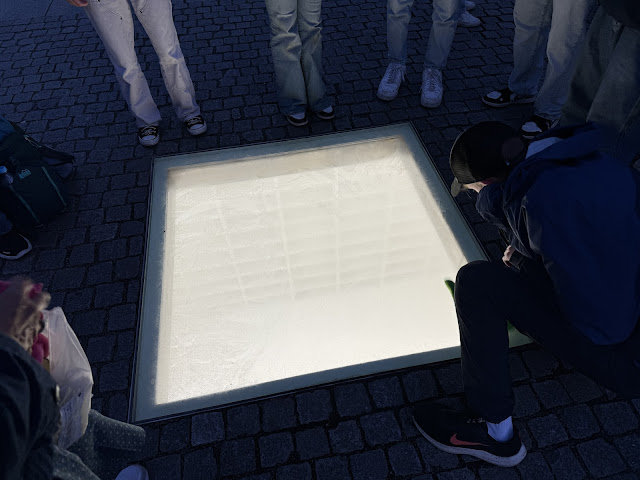
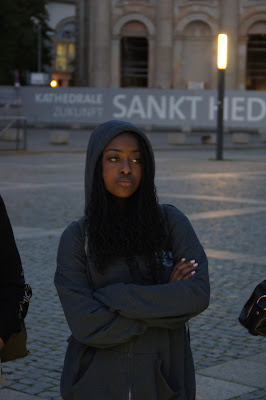



What an amazing day! So cool to hear about and see your work with cleaning the stolpersteins and the conversations that followed. Really appreciate the blog's summary of in-depth conversations about numerous issues. Thank you for conveying not just what you are doing and seeing, but also your thoughts and considerations. Between your tour of E Germans' citizens' clandestine attempts to escape the DDR and also EGermany's Stasi and its extensive efforts to spy on its own people, you understand the extent of the DDR as a police state. This week have also experienced the great cosmopolitan city of Berlin.
ReplyDelete